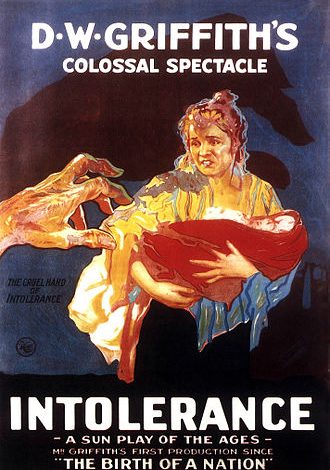Intolerance

Intolerance is a 1916 epic silent film directed by D. W. Griffith. Subtitles include Love’s Struggle Throughout the Ages and A Sun-Play of the Ages.[2][3]
Regarded as one of the most influential films of the silent era (though it received mixed reviews at the time),[4] the three-and-a-half-hour epic intercuts four parallel storylines, each separated by several centuries: first, a contemporary melodrama of crime and redemption; second, a Judean story: Christ’s mission and death; third, a French story: the events surrounding the St. Bartholomew’s Day massacre of 1572; and fourth, a Babylonian story: the fall of the Babylonian Empire to Persia in 539 BC. Each story had its own distinctive color tint in the original print, but not in the currently available versions.[3] The scenes are linked by shots of a figure representing Eternal Motherhood, rocking a cradle.[3]
Griffith chose to explore the theme of intolerance partly in response to his previous film The Birth of a Nation (1915) being criticized by the NAACP and other groups for perpetuating racial stereotypes and glorifying the Ku Klux Klan.[5][6] Intolerance was not, however, an apology, as Griffith felt he had nothing to apologize for;[4] in numerous interviews, Griffith made clear that the film was a rebuttal to his critics and he felt that they were, in fact, the intolerant ones.[7] In the years following its release, Intolerance would strongly influence European film movements. In 1989, it was one of the first films to be selected for preservation in the United States National Film Registry.
The film consists of four distinct, but parallel, stories—intercut with increasing frequency as the film builds to a climax—that demonstrate humankind’s persistent intolerance throughout the ages. The timeline covers approximately 2,500 years.
The ancient “Babylonian” story (539 BC) depicts the conflict between Prince Belshazzar of Babylon and Cyrus the Great of Persia. The fall of Babylon is a result of intolerance arising from a conflict between devotees of two rival Babylonian gods—Bel-Marduk and Ishtar.
The Biblical “Judean” story (c. AD 27) recounts how—after the Wedding at Cana and the Woman Taken in Adultery—intolerance led to the Crucifixion of Jesus. This sequence is the shortest of the four.
The Renaissance “French” story (1572) tells of the religious intolerance that led to the St. Bartholomew’s Day Massacre of Protestant Huguenots fomented by Catholic royals.
The American “Modern” story (c. 1914) demonstrates how crime, moral puritanism, and conflicts between ruthless capitalists and striking workers help ruin the lives of marginalized Americans. To get more money for his spinster sister’s charities, a mill owner orders a 10% pay cut to his workers’ wages. An ensuing workers’ strike is crushed and The Boy and The Dear One make their way to another city; she lives in poverty and he turns to crime. After they marry, he tries to break free of crime but is framed for theft by his ex-boss. While he is in prison, his wife must endure their child being taken away by the same “moral uplift society” that instigated the strike. Upon his release from prison, he discovers his ex-boss attempting to rape his wife. A struggle begins and in the confusion the girlfriend of the boss shoots and kills the boss. She escapes and The Boy is convicted and sentenced to the gallows. A kindly policeman helps The Dear One find the real killer and together they try to reach the Governor in time so her reformed husband will not be hanged.
